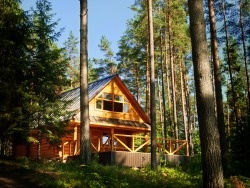 Log home living is an increasing trend by homeowners, trapped in a highly technological world, to get back to a more natural environment. Log homes are no longer just the quaint, simple cabins hearkening back to Little House on the Prairie. What was once a weekend retreat is now a year round oasis. In this 3-part series, we’ll tell you all about the recent trends in log home building. Part one will focus on Location and Foundation.
Log home living is an increasing trend by homeowners, trapped in a highly technological world, to get back to a more natural environment. Log homes are no longer just the quaint, simple cabins hearkening back to Little House on the Prairie. What was once a weekend retreat is now a year round oasis. In this 3-part series, we’ll tell you all about the recent trends in log home building. Part one will focus on Location and Foundation.
Location
Location is one of the most relevant aspects of log home building. Homeowners interested in timber home living have a love of nature. This is a consistent theme among modern log homebuilders. Land is purchased in wooded and natural environments. The newer construction takes into account not only physical location, but also the direction that home elements face in order to maximize Mother Nature’s free utilities, namely the sun and the wind.
Choosing the best home site and ideal orientation to keep the house warm in cold climates and cool in hotter locations will have a lasting impact on comfort and utility bills. In general, placing the long axis of your home in the East/West direction and designing the southern side with plenty of windows creates a passive solar structure that will minimize heating costs in the winter while keeping your home cooler during the summer months.
Utilizing existing evergreen trees and/or hillsides on the northern side can create a windbreak that will further reduce winter heating expenses; conversely, deciduous trees provide cool shade when the weather is hot while still allowing sunshine to penetrate into your home after the weather has cooled and the trees have lost their leaves.
Foundation
A strong foundation is paramount to a well-built log home. Water sources such as streams or ponds must be considered for both esthetic advantages as well as their potential to undermine your home's foundation. Choosing a home site near the top of a slope or hill can minimize any possible water damage while enhancing the overall views.
As with any home, there are multiple options for foundation styles. Historically, a slab foundation has been used more heavily in the South. Slab use in the North has been limited by climate related constraints, namely it must rest below the frost line, which can be a hindrance. Advancements in slab construction have made this less of a concern with the introduction of frost-protected shallow foundations that prevent frost heave.
However, the trend towards making all space a usable living space has led to an increase in finished basements regardless of climate. For this type of construction, a poured concrete or pre-fab concrete foundation will be best, allowing you to use all levels of your home while providing a strong support system.
Log home living is a way of life. Homeowners are breaking from the crowded life of cities in favor of a more peaceful existence. Log homes are often highly customized by their owners. Log homeowners tend to not only respect nature, but also value it. Using the most efficient building practices and eco-friendly materials are important to them. They source their materials carefully and choose building products and construction fasteners like Jumbo SCRAIL® available through FASCO America® that help them work more efficiently to minimize their environmental impact and maximize the life of their log home.
Stay tuned for the next installment of our 3-part series to learn about trends in materials for log home construction. You can also download our whitepaper that details the many considerations you must make when planning a log home construction project.

.svg.png)
